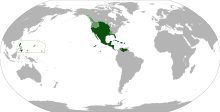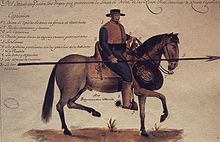Dragones de Cuera
The Dragones de cuera ( leather dragoon or Cuera dragoon ) were a Spanish border and colonial police force in the viceroyalty of New Spain or the later Republic of Mexico . It existed from 1729 to approx. 1842 and operated at times from Louisiana , Texas and New Mexico to the California coast, mainly against Indian tribes such as. B. Comanches . Its name is derived from the cuera (cuero = Spanish : leather ); an armor to protect the upper body from arrows and lances .
function
Established in 1729, the dragoons were recruited from the local population, but were legally equal to the Spanish troops of their homeland and were better paid than the troops raised in the viceroyalty. The officers were generally Creoles , the NCOs and dragoons mestizos .
Based on a chain of presidios , small forts , they operated company-by-company . They carried out research and punitive expeditions into Indian areas and secured missions and settlements, including those of friendly settled Indian tribes. The main opponents were nomadic Indians such as the Comanches and Apaches .
equipment
In contrast to the normal Spanish dragoons, which had two horses, the leather dragons had six and an additional mule . The normal, plain and practical uniform was blue. The short jacket had a red collar and red cuffs. The name of the association's location was embroidered on the leather bandelier , e.g. B. San Antonio . The hair was worn long. A flat hat with a wide brim, as worn by Mexican cattle herders , the charros , served as headgear .
Over their uniform, the dragoons wore quilted leather armor in the style of the Aztec warriors of the early 16th century, the cuera, which provided protection from arrows and lances, and leather trousers similar to the clothing of the jagunços of the Brazilian Sertão to protect against thorn bushes. A lance served as the main weapon. There was also a carbine , two pistols , a saber , a dagger and a leather shield with a round or Moorish shape. The shield bore the royal coat of arms .
Their importance for border security is shown by the fact that the dragoons were incorporated into the new Mexican national army after the founding of the Republic of Mexico in 1823 and now wore a Mexican cockade on their hats instead of a Spanish one . They were dissolved around 1842.
literature
- Martin Windrow / Gerry Embleton: The uniforms in North America from 1665 to today , Stuttgart (Motorbuch Verlag) 1975, p. 57f. u. 64. ISBN 3-87943-387-9
- José Maria Bueno: Uniformes militares españoles. Tropas Virreynales , Vol. 1: Nueva España, Yucatán y Luisiana , Málaga (self-published) 1983.
- Fernando Martínez Laínez: Banderas Lejanas. La exploración, conquista y defensa por España del territorio de los actuales Estados Unidos , Madrid (Edaf) 2009. ISBN 978-84-414-2119-6
- Joseph Hefter: Crónica del traje militar en México del siglo XVI al XX , México 1968 (Artes de México / Frente Nacional de Artes Plásticas). ISSN 0300-4953 . (Text in Spanish, English, French and German)
Web links
- Reconstruction drawing of a Cuera dragoon from 1774
- Report on the presidios and leather dragons from July 13, 2013
Individual evidence
- ↑ Bueno 1983, p. 21.

